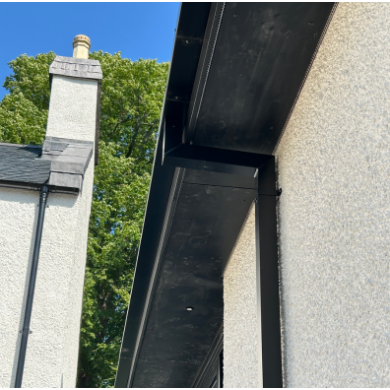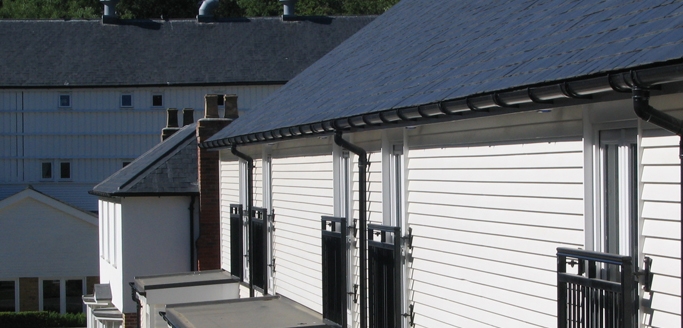
When it comes to protecting a building from rainwater damage, guttering is one of the most critical components of your property’s exterior. Yet, it’s also one of the most overlooked until it fails. Understanding how long different guttering systems last and what factors affect their longevity is crucial for planning maintenance, budgeting for replacements, and selecting the right material for your property.
In this guide, we’ll explore why the lifespan of guttering matters, compare the life expectancies of different materials, discuss the factors that affect their performance, and share maintenance tips to help you maximise the value of your investment.
Why Guttering Longevity Matters
Replacing guttering isn’t just a matter of aesthetics; it's about protecting your building’s structure and avoiding costly water damage. When gutters fail, water can overflow or leak into walls, roofs, or foundations, leading to rot, mould growth, or even structural weakening over time.
Long-lasting guttering systems provide three major benefits:
- Reduced replacement costs: Quality materials may cost more initially, but they offer better value in the long run by lasting for decades rather than years.
- Consistent performance: Gutters that hold their shape and resist corrosion continue to direct rainwater efficiently, protecting your building season after season.
- Fewer maintenance demands: The more durable the material, the less frequently it requires repainting, resealing, or replacement of parts.
When deciding which guttering system to install, the question isn’t just how much it costs but how long it will last and perform reliably.
Metal guttering typically lasts longer in rural areas than in urban settings. This is mainly because city environments expose materials to harsher conditions, such as higher levels of salt and air pollutants, whereas rural locations provide a cleaner, less corrosive atmosphere. However, when metal systems are finished with high-quality coatings and maintained regularly, they can achieve the same long lifespan in urban areas as they do in the countryside.
Average Lifespan by Guttering Material
Not all guttering is created equal. Each material has its own advantages and expected lifespan, depending on its quality, installation, and environmental conditions. Below is a breakdown of how different materials typically perform.
Aluminium Guttering: 30–50 Years
Aluminium guttering is one of the most popular guttering materials in both residential and commercial settings. It’s lightweight, rust-resistant, and easy to install, making it ideal for most property types.
With proper installation and periodic cleaning, aluminium guttering can last between 30 to 50 years. Its resistance to corrosion makes it suitable for areas with high rainfall or coastal exposure; however, saltwater can eventually cause pitting if not properly maintained.
Best suited for: Homes, offices, and light commercial buildings looking for a balance of longevity, cost, and appearance.
Cast Iron Guttering: 50–100 Years
Cast iron guttering is the traditional choice for heritage and period properties and for good reason. It’s incredibly durable, capable of lasting up to a century when properly maintained. Its strength and classic appearance make it ideal for restoration projects and listed buildings where authenticity is key.
However, cast iron does require ongoing care. Regular painting and inspection help prevent rust, and joints need to be checked periodically for leaks. If neglected, corrosion can significantly reduce its lifespan.
Best suited for: Period properties, listed buildings, and heritage restorations where long-term durability and authentic design are essential.
Steel Guttering: 25–40 Years
Steel guttering offers the strength of cast iron but in a lighter and more affordable form. Galvanised or stainless steel gutters can last 25 to 40 years, depending on the coating and exposure.
Zinc-coated (galvanised) steel provides excellent protection against rust, while stainless steel versions are even more corrosion-resistant. However, scratches or poor installation can expose steel to rust, so regular inspection is important.
Best suited for: Industrial buildings, commercial projects, and modern homes where strength and resilience are key.
PVC Guttering: 10–20 Years
PVC, or uPVC, guttering is the most common option for domestic properties due to its low cost and ease of installation. However, it has the shortest lifespan, typically 10 to 20 years and can become brittle or fade under prolonged UV exposure.
While it’s an affordable option for quick replacements or short-term projects, it may not withstand harsh climates or prolonged exposure to heavy rainfall over many years. Expansion and contraction in extreme temperatures can also cause joints to loosen over time.
Best suited for: Residential properties and extensions where cost-effectiveness is the main consideration and maintenance is minimal.
Copper & Zinc Guttering: 60+ Years
Copper and zinc guttering features premium materials that offer exceptional longevity, often lasting 60 years or more, with some installations exceeding a century. These materials develop a natural patina over time, acting as a protective layer against corrosion.
They’re low-maintenance and highly resistant to the elements, making them ideal for high-end or architecturally distinctive projects. The higher upfront cost is offset by their unmatched lifespan and elegant appearance.
Best suited for: Premium builds, architect-designed homes, and properties seeking both durability and aesthetic appeal.

Factors That Affect Guttering Longevity
Even the best materials can deteriorate faster than expected without proper care or installation. Several factors influence how long your guttering system will last:
1. Environmental Conditions
Properties located near the coast are exposed to salt-laden air, which accelerates corrosion, particularly for steel and aluminium. Areas with frequent storms or heavy rainfall can also stress joints and brackets over time.
For homes surrounded by trees, leaf accumulation and organic debris can trap moisture, leading to faster degradation or blockages.
2. Quality of Installation
Even the most durable guttering material can fail early if it’s poorly installed. Incorrect pitch, misaligned joints, or inadequate support brackets can lead to pooling water, sagging, or leaks. Always use a qualified installer to ensure proper fall and secure fittings.
3. Maintenance Routine Neglected gutters are more likely to clog, overflow, or corrode. Regular cleaning and inspection, ideally performed twice a year, can significantly extend the lifespan of your system. Prompt repairs to joints, brackets, and coatings also help preserve performance.
4. Material Thickness & Coating
For metal gutters, the thickness and quality of the coating are crucial. Thicker aluminium or galvanised steel gutters resist denting and corrosion better than cheaper alternatives. Protective finishes, such as powder coating or painting, can extend the lifespan by shielding against moisture and UV rays.
Maintenance Tips by Guttering Type
Regular maintenance not only extends lifespan but also helps identify early warning signs of damage.
Here’s how to care for each material type effectively:
Aluminium
- Clean twice a year to remove leaves, moss, and dirt that can trap moisture and cause damage.
- Inspect for corrosion or pitting, especially in coastal areas.
- Repaint or reseal joints every few years to maintain watertight seals.
Cast Iron
- Repaint every 5–10 years to prevent rust from forming.
- Check for cracks or flaking paint that may expose metal.
- Ensure all joints and fixings are tight and free of corrosion.
- Apply a rust inhibitor if repainting is due.
Steel
- Inspect regularly for scratches or chipped coatings, as these can serve as entry points for rust.
- Touch up damaged areas with zinc-rich paint.
- Ensure gutters are sloped correctly to prevent water from standing.
PVC (uPVC)
- Clean frequently, as algae and dirt buildup can discolour the surface.
- Check for sagging or leaks after extreme weather.
- Replace any cracked sections immediately, as repairs are usually temporary.
Copper & Zinc
- Avoid abrasive cleaning; the patina layer protects the metal.
- Ensure dissimilar metals (like steel screws) don’t come into contact to prevent galvanic corrosion.
- Periodically check joints and outlets for blockages, as leaves can trap moisture and slow drainage.
How to Know If Your Guttering Needs Replacing
Even with maintenance, all guttering eventually wears out. Here are signs your system may need repair or replacement:
- Frequent leaks or dripping joints
- Rust patches, cracks, or brittle plastic
- Sagging sections or uneven falls
- Peeling paint or coating (for metal gutters)
- Overflowing water during rain despite cleaning
- Damp patches or water marks on walls or fascia boards
If your guttering system shows several of these symptoms, it may be more cost-effective to replace it than to continue repairing it. As a general rule, inspect your gutters at least once a year to identify potential issues early.

Choosing the Right Guttering for Your Property
When selecting guttering, think beyond just price. Consider the property type, architectural style, and expected maintenance level. For example:
Modern homes and commercial buildings: Aluminium or steel offers a sleek look and long-term performance.
Heritage and restoration projects: Cast iron remains the best match for traditional aesthetics and longevity.
Budget-conscious homeowners: PVC provides an affordable solution with easy installation.
High-end or coastal properties: Copper and zinc provide unmatched durability and resistance to corrosion.
Each material brings a unique balance of cost, appearance, and lifespan. Investing in higher-quality guttering may seem costly upfront, but it pays off through reduced maintenance, longer service life, and fewer replacement expenses.
Thinking Beyond the Installation
Guttering isn’t something you replace often, and that’s exactly why making the right choice is so important. By understanding how long each material lasts and how maintenance impacts lifespan, you can make an informed decision that protects your property for decades.
Whether you’re restoring a period home or installing a modern drainage system, the right guttering ensures your building stays dry, protected, and performing efficiently.
If you’re unsure which system best suits your property, contact Gutter Centre for a quote or for expert advice. Our team can help you compare materials, estimate installation costs, and select a guttering solution built to last.
